Have you ever wondered if it’s worth investing in a really nice wooden salad bowl, or is it the sort of thing that needs to be replaced every so often?
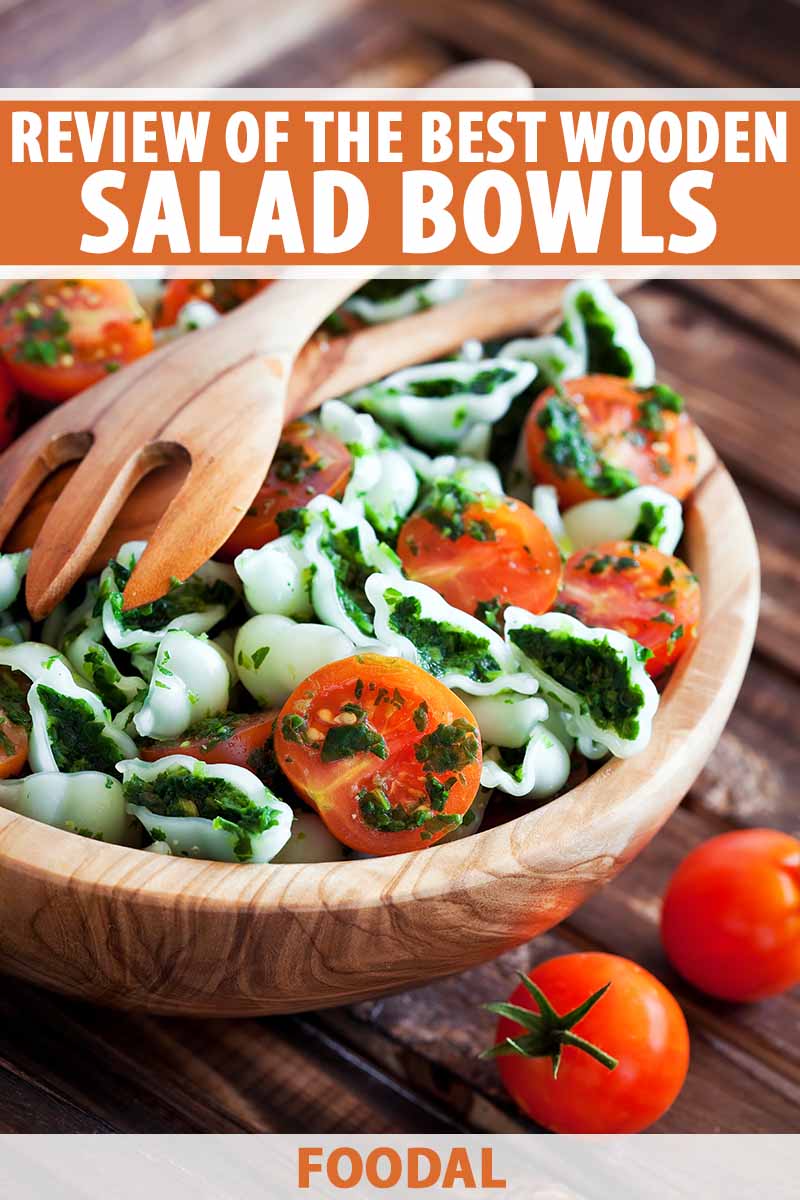
A good bowl can last indefinitely – if it’s well cared for and maintained regularly.
In fact, this serving vessel can easily last long enough to become a family heirloom. And quality pieces produced according to exacting standards may even become collectables.
So, let’s begin with a thorough product review of some of the top-selling wooden salad bowls and salad bowl sets currently available.
Then we’ll have a look at some features that ensure their longevity, and how to care for them.
Foodal’s Guide to Wooden Salad Bowls
- Bay Isle Home Saorise
- Lipper International Acacia Wave
- Loon Peak Fullilove
- Millwood Pines Lala Set
- Nambé Anvil
- Reubens Bamboo
- World Menagerie Kalmar Set
The Best Bowls and Sets
Take a look at our reviews of some of today’s popular wooden salad bowls and sets!
We’ve included both individual options and sets, so you have a wide variety of options to choose from when selecting what is best for your home.
If “cohesion” is your word of choice when setting a table, you should consider buying an entire set, complete with a large serving bowl, matching individual bowls, and matching serving utensils.
Otherwise, a single serving bowl will be the way to go, making a beautiful addition to your collection of much-loved servingware.
1. Bay Isle Home Saoirse
If showmanship is a top priority for any dinner party you host, consider becoming the proud owner of an impressive salad bowl that can be displayed on a tall stand.
Bay Isle Home Saoirse, available on Wayfair
Embody all the pomp and circumstance of an elegant salad course with the Bay Isle Home Saoirse wood salad bowl. It includes a serving bowl, pedestal stand base, and mixing spoon and fork.
All items are made of rubberwood finished with a cherry stain.
The bowl is not attached to the stand, and can be moved to and from the kitchen when you are prepping your salad. The utensils can be placed on a hook attached to the base when not in use.
The pedestal stand features decorative indented rims around each of the three legs for subtle aesthetic detail.
The round bowl on its own is 16 inches in diameter and 5.5 inches in depth. It holds approximately 12 quarts.
When the bowl is on the stand, the entire product is 30 inches high and 16 inches wide, and weighs a total of 12.45 pounds.
Review the details and find purchasing information now on Wayfair.
2. Lipper International Acacia Wave
Lipper International’s wood serving bowl with a wavy rim is made of natural acacia wood in segmented, vertical slats.
Lipper International Acacia Wave, available on Wayfair
It is a round, tapered bowl measuring 12 inches in diameter at the rim, and 7 inches in height. Its tall sides offer a generous depth for easy salad tossing.
It weighs 1.55 pounds, and has a capacity of approximately 5 quarts.
Its lustrous grain, natural appearance, sturdy construction, and contemporary wave design make it the perfect presentation piece for serving food as well as displaying on its own when not in use.
The natural color of the acacia wood is not stained – this particular wood is quite durable, and a good choice when you like to dine both indoors and outdoors.
Utensils are not included with this purchase.
Lipper International also sells a smaller version of this design, ideal for individual servings or more intimate gatherings. It’s available on Amazon. This smaller bowl has a diameter of 6 inches and a height of 3 inches, and weighs 4 ounces. It has a capacity of 2.5 cups.
Check prices and read customer reviews now on Amazon and Wayfair.
3. Loon Peak Fullilove
For an organic, natural look that eschews clean finishes in favor of raw and rustic edges, Loon Peak’s Fullilove wood serving bowl is yours to cherish!
Loon Peak Fulllilove, available on Wayfair
This large, hand-carved bowl is made from reclaimed fir root, and each rounded bowl is unique. These measure roughly 5 inches in height, 18 inches in length, and 20 inches in diameter, with a 2-quart capacity, weighing in at about 5 pounds.
These measurements will vary slightly from purchase to purchase. This piece certainly is not a factory-machined/factory-made, cookie-cutter product!
Note that each individual bowl will be carved and shaped differently, based on the qualities of the wood, and may not be identical to the images provided on the seller’s website.
Due to natural wood variations, no two items will have the same exact grain color or knots. Your bowl will be uniquely yours!
Doubling as both an artistic display piece and a serving platter, the bowl is coated in a food-safe lacquer finish.
Loon Peak offers this fir root design in a few different sizes. Other than the largest size described here in detail, you can also purchase the Fritch hand-carved bowl with a 12-inch diameter or the Frisina with an 8-inch diameter.
Take a closer look at this gorgeous design, prices, and customer reviews on Wayfair.
4. Millwood Pines Lala Set
The Millwood Pines Lala wood salad bowl Set includes everything you’ll need for serving your guests with bowls and utensils that are designed in a cohesive style that will bring an element of warmth and richness to the table.
Millwood Pines Lala Set, available on Wayfair
This set includes seven separate pieces: a large serving bowl, four individual salad bowls, and a pair of utensils – one fork and one spoon.
The serving bowl is 5 inches high, 11.75 inches wide, and 11 inches in diameter. The individual salad bowls are each 3 inches high, 7 inches wide, and 6.5 inches in diameter.
All of the bowls are designed in an oblong shape. The solid rubberwood material is finished in a warm brown stain for each piece.
Find this set now on Wayfair.
5. Nambé Anvil
The Nambé Anvil salad bowl with servers is a sleek, beautifully designed option in an oval shape that will be a showstopping serving platter on your dining table.
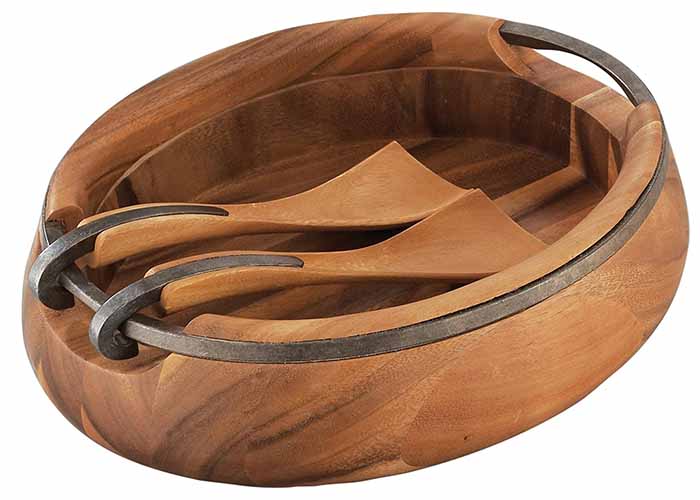
Nambé Anvil, available on Amazon
The extra details of an iron-finished Nambé alloy blend around the rim of the bowl and on the handles of the serving utensils provide a unique contrast with the segmented light brown acacia wood.
When not in use, the curved handles of the spatula-shaped serving utensils perfectly fit over the rimmed handles and rest inside the platter.
The bowl weighs 4 pounds, and measures 16 inches long, 13 inches wide, and 5 inches high. It holds roughly 15 quarts. The serving fork and spoon are 14 inches long.
Read customer reviews and find current prices on Amazon and Wayfair.
6. Reubens Bamboo
Have you always loved the lightweight yet durable qualities of eco-friendly bamboo?
This wooden bamboo serving bowl from Reubens will be a most welcome addition to your collection, especially when you’re looking for a smaller bowl for personal use for daily meals.

Reubens Bamboo, available on Amazon
The diversely segmented round bamboo bowl is 8 inches in diameter and 3.15 inches in height, and weighs 1 pound. The smaller size is an ideal choice to mix and present salads in style for a larger single serving, or for two smaller servings.
The thicker width provides extra durability and resilience to cracking and other damage. Three carved lines around the bowl bring a modern sense of design detail.
Find current prices and read customer reviews on Amazon now.
7. World Menagerie Kalmar Set
With a subtly concave design to the straight sides, this vertically segmented Kalmar 7-piece acacia wood set from World Menagerie has a bold, sleek presence.
World Menagere Kalmar Set, available on Wayfair
The set includes a large serving bowl, 4 individual salad bowls, and two serving utensils.
The round serving bowl has a height of 4 inches and a diameter of 10 inches. Smaller serving bowls measure 2.5 inches tall and 6 inches across.
The total weight of the set is 4 pounds.
Find purchasing information and check customer reviews on Wayfair now.
How to Choose the Right Wooden Salad Bowl
As with most servingware and kitchen utensils, the materials and techniques used in the manufacturing process will have an impact on the quality and durability of the product.
How to decide which is the best choice? Let’s look at some key features to narrow down the options.
The Best Types of Wood
To start, wooden bowls are made of… wood!
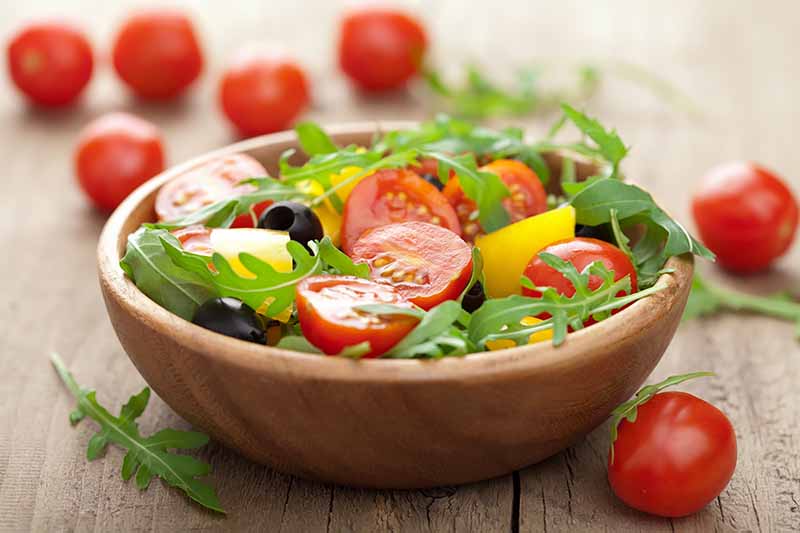
Ideally, hardwoods are best suited for making salad bowls. Hardwoods come from trees with a broad leaf, that produce a nut or fruit, and that are found in temperate regions. They lose their leaves in autumn and go dormant for the winter.
In the Northern Hemisphere these are deciduous trees, and in subtropical and tropical regions they’re mostly evergreens.
As the name implies, hardwoods are generally harder than other types of wood, and the density of their cellular structure makes them a more appropriate choice for the manufacture of servingware that can hold up to foods with a high water content, such as a salad with dressing.
Note that the finish of a product denoting the shade of stain that was used should not be confused with the actual material.
Let’s take a look at the chief varieties you will find.
Acacia
Strong and durable, and ranking high for hardness, acacia wood is water and decay resistant.
Also referred to as wattle, Acacia is a diverse genus, containing hundreds of species. It is grown primarily in Australia, but species for commercial use in woodworking are also produced throughout Asia and the Pacific Islands.
The grain patterns are also highly diverse, as they can be straight, wavy, or swirling.
With its deep, rich ribbons of amber, gold, and earth tones in the lovely natural grain, it’s an excellent and popular material for kitchenware, and takes on a deep radiance when polished.
Bamboo
Not actually a tree but a member of the grass family with wood-like characteristics, bamboo grows at an amazingly quick rate. Sustainable, strong, and lightweight, it also has antimicrobial properties that inhibit the growth of bacteria.
Plants can be ready for harvest in just four years, at a height of 60 to 70 inches.
If you’re concerned about the ecological impact of questionable harvest practices, look for bamboo that has been certified by the Forest Stewardship Council (FSC) and grown on plantations not used as a food source or habitat for the giant panda.
Black Walnut
While there are different varieties of walnut wood, the eastern American black walnut (Juglans nigra)is one of the top-rated hardwoods for durability, compatibility in woodworking, and shock resistance. With a gorgeous contrast of light and dark browns that requires no staining, it is a good choice for foodware.
Black walnut is generally found throughout the central and eastern regions of Canada and the United States.
The grain is usually straight, but can have some irregularities of waves and curves. Black walnut wood will gradually lighten in color over time.
You may find a hint of walnut fragrance and flavor in the bowl that may be transferred to foods, which will fade with time.
Cherry
Cherry wood is a straight, smooth-grained option that features a contrast between the rich, dark heartwood of the tree’s interior, and the light, creamy sapwood from the outer part of the tree. Small bits of mineral deposits occur naturally throughout the fine grain, adding little flecks of black detail.
Cherry wood, specifically American black cherry (Prunus serotina), is a highly popular domestic wood that is widely available to source for woodworking throughout the midwestern and eastern United States.
It is known for its outstanding durability and the way its appearance improves over time, taking on a luster of deep, rich tones. And because of these deep tones, it doesn’t need to be dyed or stained, so it’s 100% safe for serving food.
Douglas Fir
Mainly found in western North America, Douglas fir (Pseudotsuga menziesii) has a straight or slightly wavy grain and medium or coarse texture.
Among the softwoods commercially available in North America, Douglas fir is considered to be among the hardest and heaviest varieties. With its stiff and strong qualities, this wood is suitable for use in furniture, construction, and boating vessels as well as servingware.
It also responds well to stains and finishes.
Maple
Maple is another durable and attractive wood that’s safe for use with food.
Hard maple is the timber gathered from the sugar maple tree (Acer saccharum), a hardy species that grows well in the cold climates of the northern US and Canada. You can read more about it in this guide on our sister site, Gardener’s Path. And of course, you may already be familiar with these trees as this is the kind that’s tapped to make maple syrup.
The wood has a tight and fine texture. It is generally straight-grained, though it can sometimes be curly or wavy. It is among the most dense domestic American hardwoods, and one of the most readily available types for commercial use in the United States.
The pale color of maple gives it a light, rustic appearance that is charming and unpretentious. Like cherry, it gets better with age as it takes on a darker color.
Olive
Originally from the Mediterranean, olive wood is strong, heavy, and dense, and features rich, earthy-brown streaks flowing with the lighter blond tones of the sapwood. It is straight-grained and has a fine, closed texture.
It is known for the lustrous sheen it takes on with polishing.
Like walnut, olive may have a lingering, sweet aroma that fades with time.
Rubber
A medium-density tropical hardwood sourced from the Pará rubber tree, rubberwood is a durable option that is highly resistant to cracks and shrinkage.
It is native to Brazil, and is now cultivated throughout many tropical regions.
The grain is straight, and has a coarser, more open texture with larger pores than other varieties of hardwood. It also has antimicrobial properties and mild flame retardance.
Strong and flexible, it is easy to manipulate, and its light color makes it easy to stain.
Teak
Dark wavy threads run throughout the grain, creating stunning highlights in teak’s characteristic profile.
Teak is native to South Asia, and is currently grown throughout Africa, Asia, and Latin America in tropical regions.
A naturally water- and decay-resistant hardwood, teak is very suitable for use in the kitchen. However, it still requires the usual light seasoning after use to protect it.
Wood to Avoid
The following are types of wood that should not be used for kitchenware, though you will often come across products that suggest otherwise.

These options are best for the manufacture of display pieces, rather than dining items.
Beech
Beech does not have the durable characteristics needed for kitchenware. Without treatment, beech will yellow, fade, and eventually turn gray in color. This may be compensated for with staining or dying, which may not be food safe. Keep an eye out for products that are stained or sealed only with food-safe stains, varnishes, or shellac.
Oak
Lovely to look at, oak servingware just isn’t very durable. Easy to chip and split, these pieces also tend to shrink as they mature – and oak usually requires a stain to bring out its features. Always avoid stained products not labeled as food safe.
You should especially avoid dishes and other products made from red oak – they have an open and porous cell wall that allows moisture to pass through.
White oak (Quercus alba), however, is considered a more durable option for servingware. More resistant to water, it has been used in the past for crafting wine and liquor barrels as well as boats.
Birch
On the softer end of the hardwood scale, birch loses volume as it dries, making it a prime material for twisting and warping. As such, it is not appropriate for making bowls that stand the test of time.
Bowl Construction
The way in which a bowl is constructed will result in a variety of looks, at various price points. Depending on your personal aesthetic and budget, you’ll want to review the construction of your selected pieces with careful consideration.
One-Piece
In the manufacturing process, vessels created from a single, solid piece of wood that are hand turned on a lathe and kiln dried at a low temperature will be the best choice, structurally speaking.
However, as they’re the most labor intensive, they’ll be the most expensive as well.
Segmented
There are many options for beautifully crafted vessels made of segmented pieces, glued together in a ring construction style or vertically joined in a slat-like style.
With each seam and joint, it’s worth noting that the chance of water seepage increases. Water damage may occur as a result of improper care over a long period of time.
Laminate
Laminate is a thin slice of wood glued on top of another material, such as a softwood or composite, giving it a veneered appearance. Water can enter the seams with this type of construction as well, causing damage and lifting the laminate.
Food-Safe Finishes
The type of finish on your wooden bowl is also another area of consideration, for not only for the safety and durability of your servingware, but also for its visual aesthetic.
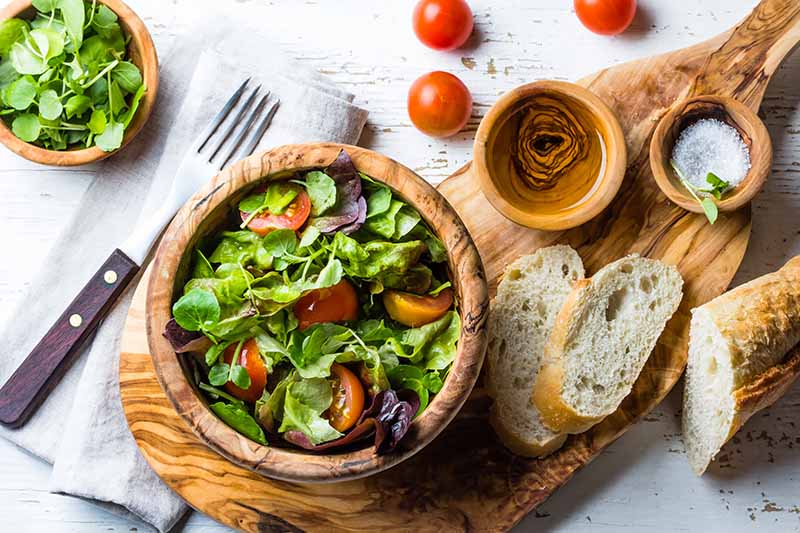
You want to ensure that the finish or stain used to treat your wooden bowl is a food-safe, nontoxic product. Because the food you choose to serve will be in direct contact with the wood, this is an important health concern as you shop for a new bowl, and as you care for it at home.
Stains
Wood stains provide depth and color to the wood that may otherwise be lacking naturally. There are many color choices applied to salad bowls that will fit your personal style preferences, as well as natural options that are not stained.
Because wood stains are toxic upon initial application, a curing process is necessary afterwards in order to be considered a food-safe product.
Curing involves drying a newly stained or finished piece for anywhere from a few hours to several weeks, depending on the type of wood, the environment, and the type of stain used.
Oil
Oil-based finishes soak into the pores of wood, creating a smooth and safe barrier.
Food-grade mineral oil and pure tung oil, a nut-based finishing oil, are two safe options to use. Avoid using vegetable or olive oils to maintain wooden bowls at home, as these will quickly go rancid.
Film
As the name implies, a film finish leaves a distinct layer of a protective coating over the surface of the wood.
Shellac is a popular food-safe and water-resistant film finish that is available in multiple hues. It will create a glossy layer.
Like wood stains, a film finish also should undergo a curing process after application.
Wax
Thicker than oil and more water repellant, food-safe waxes offer a protective topcoat.
Food-grade beeswax from the honeycomb of honey bees is a common product used for finishing.
Thicker and more water-resistant than beeswax, carnauba wax is a plant-based option that can be used on its own or combined with beeswax.
Paraffin wax is another popular food-safe option.
Cleaning and Care
The majority of wooden salad bowls follow virtually the same cleaning and care rules. The main piece of knowledge to remember for any bowl – actually, for any wooden kitchen product like cutting boards – is this:
Wood and water don’t mix.
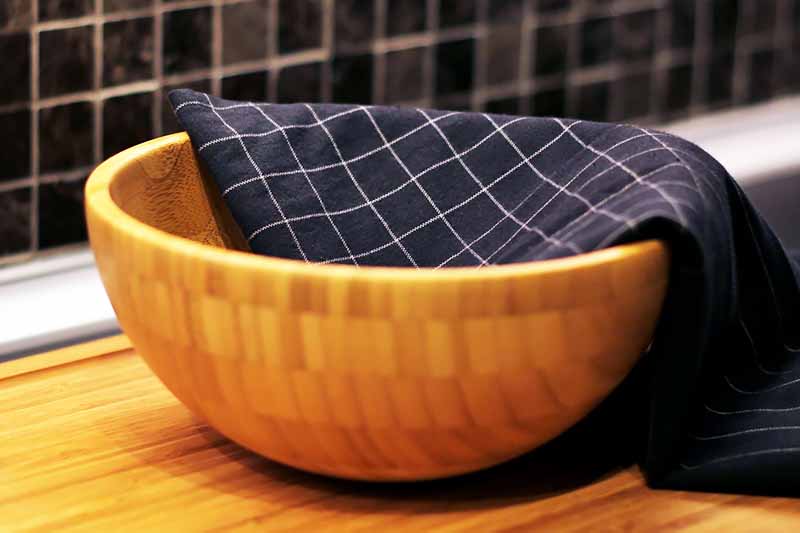
Because wood is porous, it will absorb water if any is left sitting at the bottom of the vessel, or if the dish itself is immersed in water. If the water is not dried immediately, it may also damage any finishes as well.
When wood absorbs water it will swell, sometimes resulting in cracks, twists, or splits. Hot water is particularly bad for this material.
To preserve your bowl in the best possible condition, it should only be wiped out with a damp cloth, or given the briefest of washes in warm, soapy water. Wooden salad bowls can withstand a quick wash in warm soapy water, as long as they’re inverted to drain and dried immediately with a soft towel.
Bowls should be allowed to dry completely before being put away for storage.
Never soak a wooden bowl or any wooden utensils or other components for a long period of time, and absolutely do not put them in the dishwasher.
Also, avoid rinsing them under running water and then setting them aside until you’re ready to do the dishes – especially if you tend to forget! Any water sitting in the bottom may cause damage.
To maintain the integrity of the wood, bowls should be wiped out as soon as possible after use, cleaned, dried, and then rubbed lightly inside and out with food-grade mineral oil. This can be done occasionally, after every other cleaning. Treat individual serving dishes and any wooden salad utensils in the same manner.
Try this food-grade mineral oil from Thirteen Chefs, available on Amazon in 12-ounce bottles.
Do not place these pieces of servingware in the microwave, or store them in the refrigerator or freezer.. Any extreme changes in temperature may cause the wood to crack or split.
Happy Salad Tossing!
That wraps up our overview of wooden salad bowls. Have we helped to narrow down your search? There are plenty of high-quality options available that will provide durable service featuring the natural beauty of wood.
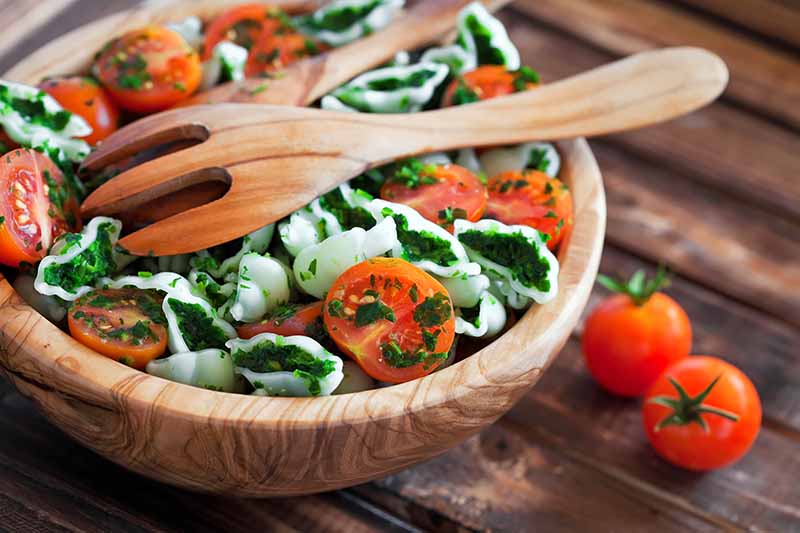
You have a wide selection in terms of materials and style, as well as your choice of individual platters and sets, often with utensils to match.
Whatever you decide to purchase, just apply routine TLC so you can enjoy years of happy salad tossing for family meals and fun dinner parties.
Do you favor one type of wood over another? What style will fit your home: clean and contemporary or distressed and rustic? Let’s chat in the comment section below – feel free to leave us a message.
Ready to complement your newly purchased salad bowl with utensils, accessories, and more? Read these guides now to complete your kitchenware collection:
- The Best Salt and Pepper Mills: 7 Top Picks Reviewed
- Pick Out the Best Kitchen Tools for Your New Home
- Cover the Basics with Made In’s Plateware
© Ask the Experts, LLC. ALL RIGHTS RESERVED. See our TOS for more details. Photo credit: Wayfair and Amazon. Uncredited photos via Shutterstock. Originally published on May 25, 2015. Last updated on October 27, 2022. With additional writing and editing by Nikki Cervone
About Lorna Kring
Recently retired as a costume specialist in the TV and film industry, Lorna now enjoys blogging on contemporary lifestyle themes. A bit daft about the garden, she’s particularly obsessed with organic tomatoes and herbs, and delights in breaking bread with family and friends.

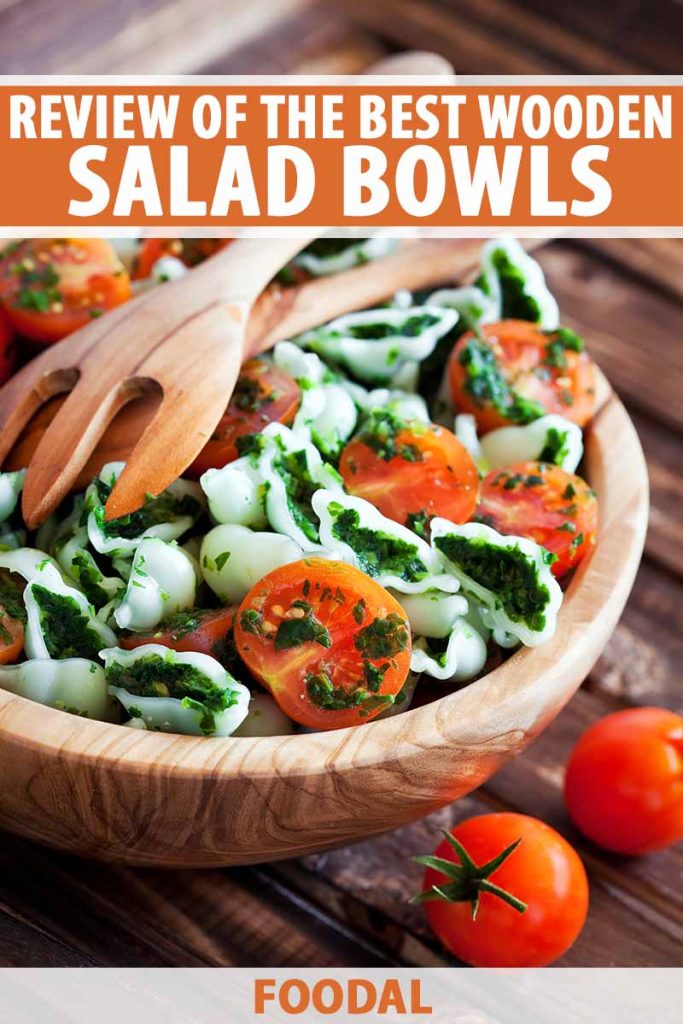
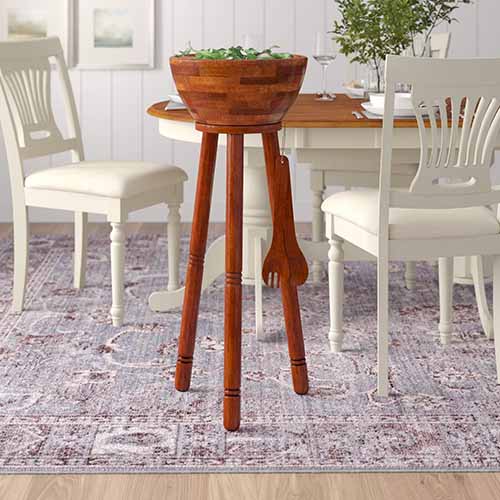

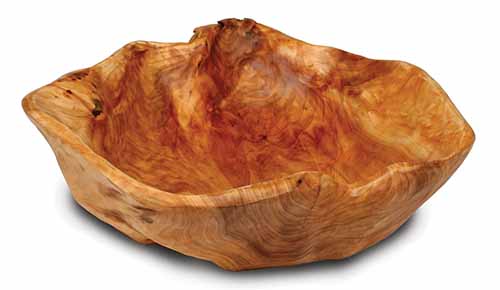
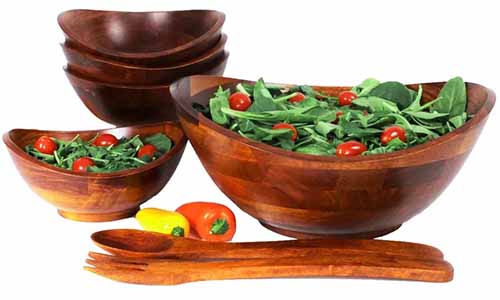
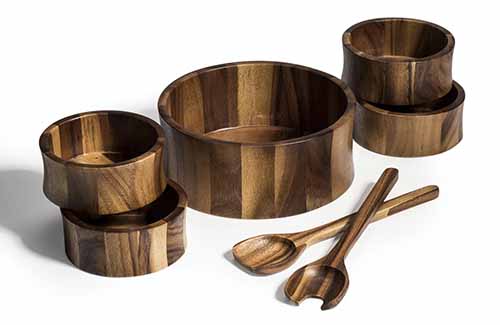

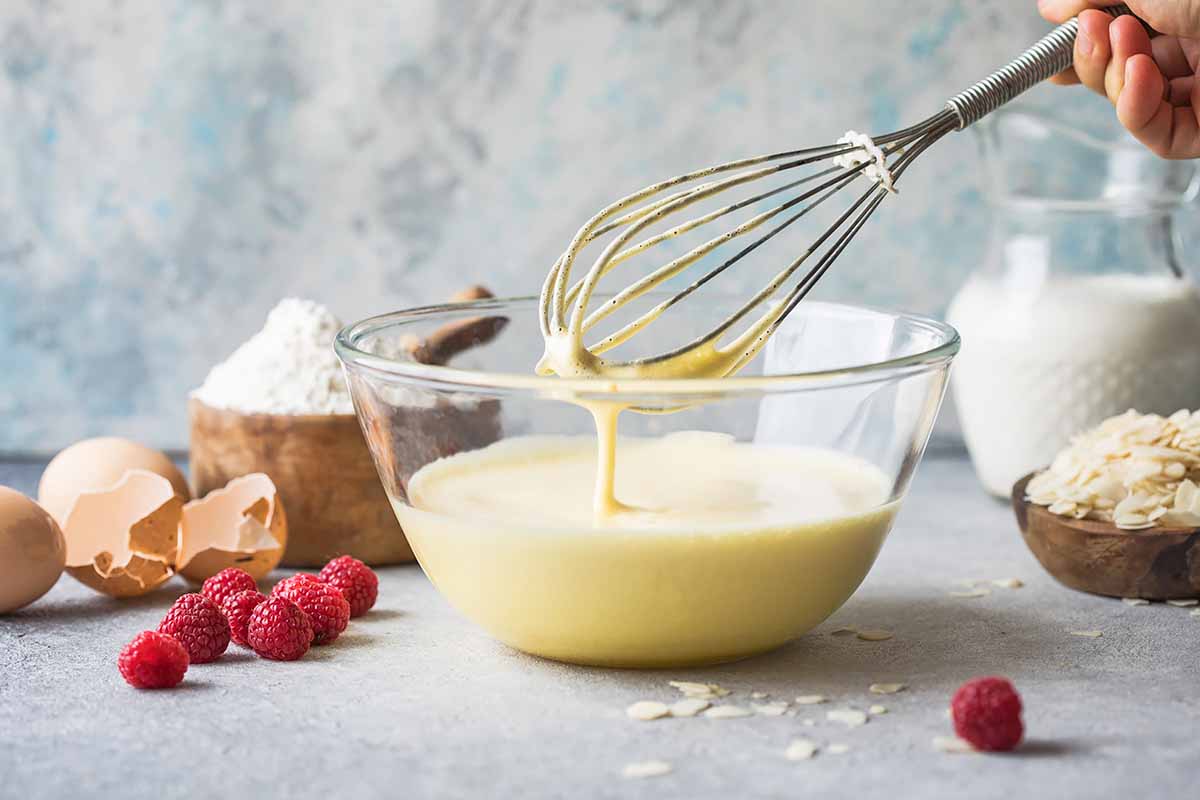
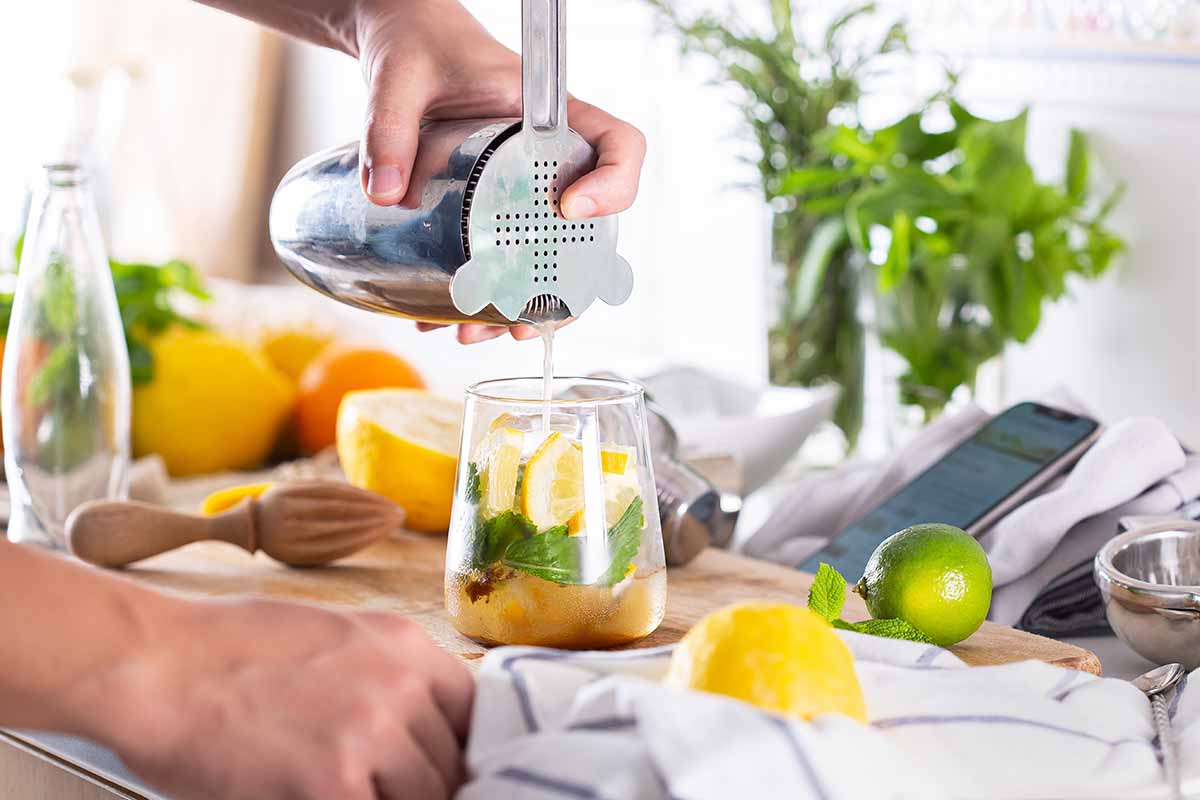
I don’t think I’ve ever eaten from a wooden bowl in my life. I often regard it as unattractive and awkward to do so, but haven’t really given it a chance. Also I constantly worry about splinters of wood showing up in a great tasting bowl of goods I’m trying to enjoy, especially after wear and tear. But now that you recommended the ones to select and avoid, maybe I might give it a go.
So..we think alike @TPhoenix…I have always disregarded having a wooden bowl in my house, I find them looking ‘queer’, not until I read this article, my perception changed. The only disadvantage will be in washing I bet, from what I gather, one has to be very careful… for preservation purposes…what I know is, am bookmarking this article up until the day I make a choice to buy one or two for starters then I’ll know whether to add more to my group of crockery 🙂
Well, I think your concerns are valid TPheonix, and like any cookware, care has to be given in the selection of wooden bowls to ensure their safety as well as longevity. One of the aspects of wooden bowls that I find most appealing is that with aging, the finish becomes more polished and richer in appearance. And as diane points out, care does have to be taken against water damage – but, like any tool of good quality, a bit of care in maintaining them will result in a lifetime of reliable service.
This is a great, comprehensive guide! I like that you specifically called out the issue of washing wooden bowls, that has always been the roadblock with me. My family feels that simply wiping or giving a light scrub is unsanitary. I can’t tell you how many times I’ve found our salad bowls in the dishwasher or sitting in a pot of water for hours *grumble*.
Before you buy an expensive bowl, make sure everyone in your house is on board with how to properly care for them!
I hear you hungryChicken, rinsing off dishes before washing is such a habitual action it can be hard to change. My ‘salad bowl radar’ is always on high alert when guests help with the clean up after dinner!
We have a lot of wooden bowls and cutting boards lying around that are from bamboo. It’s one of my favorite materials as far as utensils and whatnot are concerned. Any quality wood bowl (or similar item) is far better than a plastic bowl or something that’s not made from wood, that’s for sure.
Bamboo is a great ‘wood’ for cookware and utensils, and is definately my material of choice over plastic, considering the products used to manufacture plastics and the safety concerns of their after effects.
I think wooden bowls look great for things like fruit or bread, but that’s as far as I go for using them. I am too paranoid about the cleaning and a quick rinse is all I do. They are good for kids to use as they don’t break and good for outdoor use for the same reason.
They certainly have a natural beauty Bella, and sturdy as well.
I’ve always thought wooden bowls looked gorgeous for salads, but have been wary of the care and cleaning. The tips given are kind of a little ritual, though, so I may just have to give it a shot someday. The top-rated options are certainly lovely, I’m especially fond of the Dansk model and the Lipper cherry set.
The seasoning is a bit of a ritual Leopard, and one that I enjoy. It’s like sharpening a good knife, or cleaning a quality paint brush – you look after the tools, and the tools look after you.
I’m leery of dishes that I cannot clean and sterilize uniformly. This is why I don’t generally use them. My fears might be slightly irrational on this however. Properly cared for wooden dishes do seem to look nice. They seem durable for children.
The germ thing’s a sticking point for a lot of people nytegeek, that’s why I like to season my wood salad bowl with lemon before crafting a salad. The antibacterial agents in lemon juice and their essential oils is a powerful growth inhibitor for bacteria commonly found in food prepraration… and it adds great flavor.
These wooden serving vessels look like heaven. A lot of people eat with their eyes and serving platforms like this make your salad pop. I would worry about cleaning anything made out some something organic or was once alive – especially if it is expensive.
They are beautiful, and you’re so right about how visuals contribute to the dining experience Jasmine. Cleaning’s pretty easy, it just requires a bit of care… my one-piece maple set is over 30 years old and still looks great with just a light seasoning after each use.
A wooden bowl (and wooden ustensils in general) are something that you don’t really need but they’re just so cool to have. My mother gave me some and I fell in love with them – they look really good! The meals are definitely more enjoyable when you use these.
They are totally cool fuzyon, and they really do seem to make a salad taste better! Mother’s are so wise…
This is a good read. Thanks for the recommendations. I want to get a wooden salad bowl set but I don’t have a lot of knowledge with them. I always see different sets made with different woods and would simply gage which was the better set by price. This article has helped point me in the right direction.
Glad to be of help Kimmy, hope you find a good one!
Well that Dansk Acacia bowl looks absolutely gorgeous, and that really makes me want to get out there and see some of the other options out there. I have my wooden bowl here, but it is getting old and has been around for a while now, so I would like to think that I am due for a change here. I am intrigued by the bamboo bowls, too, and I cannot say I have ever seen one of those, but I can imagine that they are very useful and convenient, so that is a possibility. Very interesting stuff, and thanks for sharing.
She is a beauty all right… hope you find one you like!
I love good quality wooden salad bowls! I’m surprised you didn’t mention the Andrew Pearce wooden bowls (maybe you haven’t heard of them?). He comes from a long family tradition of craftsmen, and produces amazing wooden bowls in cherry and black walnut. I visit his workshop in Vermont each year on our vacation there.
Guys- had a wooden bowl for 45 years, was dropped and split in half. Received a new used one for Xmas, well taken care of and a lil larger. I am jacked to have another… You are right, the visual and crazy bond with kitchen tools enhances the food you cook…
-Mike
Wow, 45 years! You are so right Mike, the connection that we make with our kitchen tools can be lifelong, and so meaningful. Glad you were able to replace this mainstay of your kitchen. Merry Christmas!
I love my Olive wood bowls. We used to live overseas and it was quite common. We were told to increase the longevity of the bowl to use a glass insert for acidic salads. That was 60 years ago and the bowls have been passed down. The richness of the wood has blossomed over the years and it began as rich but now it has a warm nutty glow.
We have a 9” diameter by 4 1/2” deep solid teak bowl approximately 60 years old from the days when no regard was given to the trees it came from. Good as the day it was brought here from Denmark with my wife’s household goods.